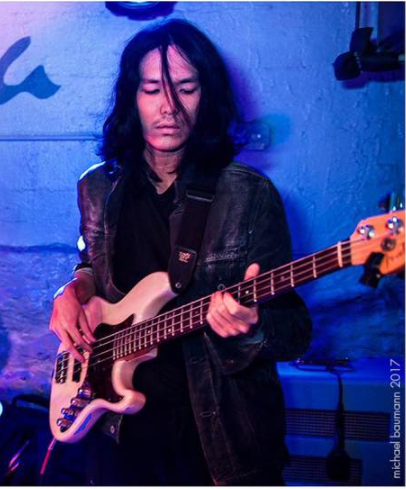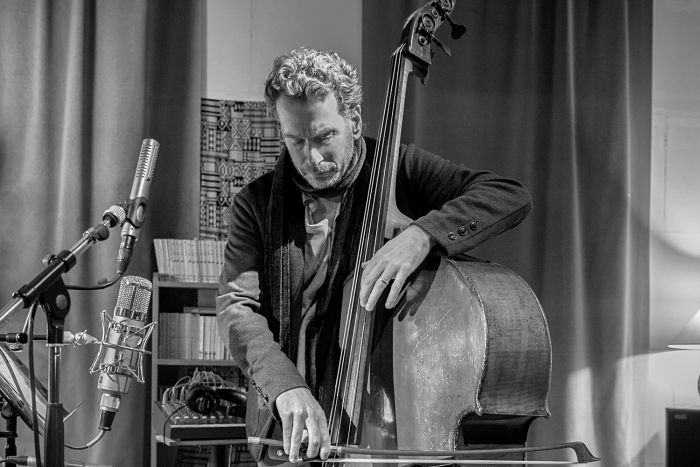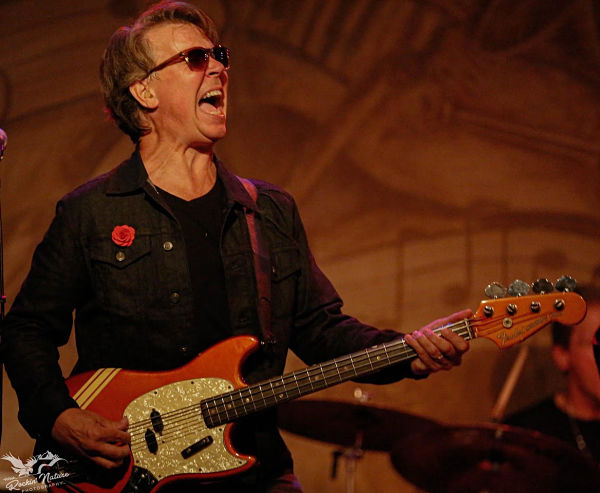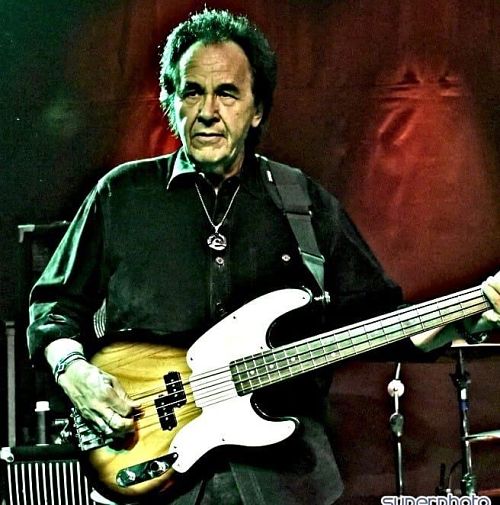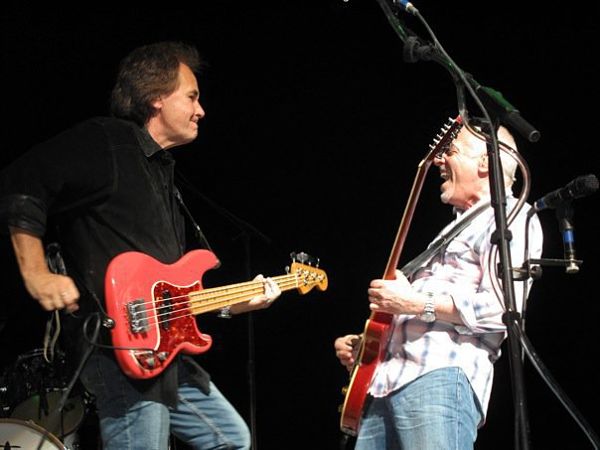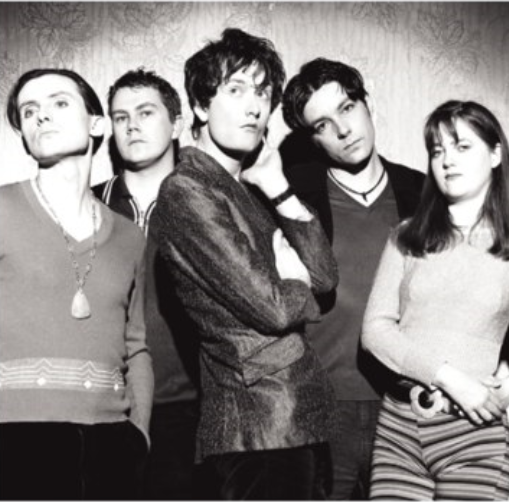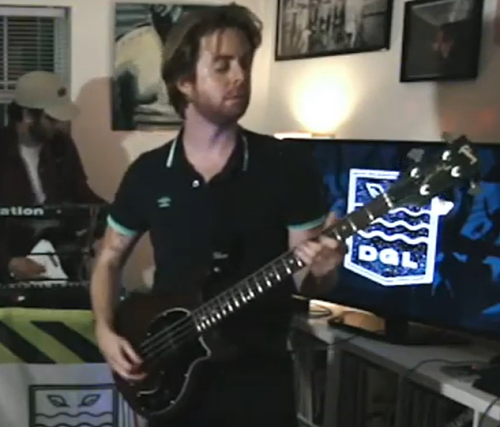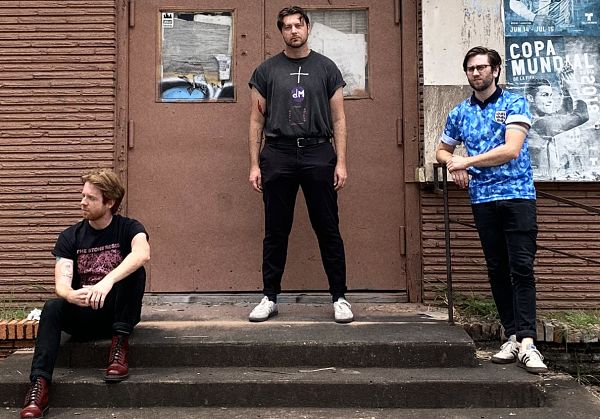
Photo by Tom Parr
By Joe Gagliardo
Bassist John Conte’s illustrious career performing and recording music is in full swing! His credits read like a who’s who in the music industry, covering multiple decades, artists and musical genres. For John, music has always been a part of his life.
His mom was a jazz singer and his dad a serious jazz aficionado whose record collection provided the soundtrack to John’s early years. Recalls Conte “some of my earliest musical memories were hearing recordings by Frank Sinatra, Nancy Wilson, Dave Brubeck, Wes Montgomery & Cannonball Adderley…”
But there were also some pop records being played around the house as well, and after hearing Simon & Garfunkel’s Bookends album at age six, John was moved to ask his mom for a guitar. His older brother Steve started out on drums, before making the guitar his main instrument a few years later. By ages nine and ten, the two brothers had started a band with a school friend of Steve’s. Inspired by The Beatles, The Monkees, and the eclectic mix of pop music on AM radio, they began writing their own songs and recording them on a portable tape recorder in the living room.
With John becoming more aware of Paul McCartney’s role in The Beatles, he began to gravitate toward the bass. For his tenth birthday he received a Harmony H-22 electric bass with the batwing pickguard.
While the Harmony was an inexpensive short scale bass, we now know that it was used by Muff Winwood on “Gimme Some Lovin’ and early hits by the Spencer Davis Group, as well as by Ronnie Lane on many Small Faces records. John still owns that Harmony bass, and it has been modified by substituting a P-Bass pickup for the original DeArmond pickup that was no longer working.
This bass has been a secret weapon for John when recording, because of its deep, resonant woody sound, and well defined “click” when played with a pick. John played that Harmony until high school, when he bought a ’77 Rickenbacker 4001, for $375.00. Playing in heavier rock bands, which began in middle school for John, would carry on through high school. “There really weren’t many other kids playing bass in a small suburban town back then, so it was known that I was a bassist,” says John. Eventually, the high school’s band director asked John to lend his talents to their jazz ensemble. This opened John’s ears to new sounds, techniques, and harmonic possibilities.
John received his first upright bass as a high school graduation gift and put it to use when he enrolled in the Jazz Studies Program at Rutgers. However, it was outside of the actual classrooms where John gleaned most of his learning. In setting out to learn the language of jazz, he immersed himself in the music, listening intently to classic albums while soaking up the bass lines of Ron Carter, Ray Brown and Paul Chambers.
Both on and off campus, John made it his business to make any jam session or accept any gig that he could, which sometimes included playing with future heavy hitters, Terence Blanchard (trumpet), Ralph Peterson (drums), and Frank Lacy (trombone).
After his college years, John began making the scene in New York City, hanging at open jam sessions, meeting other musicians and playing as much as possible. At this time, John’s musical focus was gravitating back towards and rock n’ roll, rhythm and blues, and pop. He began delving into the history of the blues, which seemed to be a natural outgrowth of his earlier affinity for the blues-based British rock bands such as Led Zeppelin, the Rolling Stones, Humble Pie, and Free.
Around this same time, John received a call from some of his former college mates, who were now on the road with Blood, Sweat & Tears. There was an opening in the bass chair, and John ended up on the road with BS&T, from 1985-1987. His first gig with the band was a trial by fire. “I learned the material by listening to a board tape from one of their recent live shows – no rehearsal. When I flew out to Seattle to do my first show, I hadn’t even met front man David Clayton Thomas.”
When not on the road, and back home in New York City, John became part of the “Under Acme Blues Night” with his band the Hudson River Rats. The ‘Rats’ were a blues / r&b band, and their fellow founding members included,Rob Paparozzi (harmonica, vocals), Steve Conte (guitar, vocals), and BS&T alumnus Tom DeFaria (drums).
The Blues Night was hosted by producer/writer/musician Jeff Kent, from the jazz/rock band Dreams. This weekly gig became quite the scene, with many other producers, musicians and celebs dropping by to sit-in with the band, including Phoebe Snow, Carole King, Cyndi Lauper, Etta James, Willy Deville, Bernard Purdie, Will Lee, and Julian Lennon.
The Rats’ residency at the Acme Bar & Grill helped put John on the map musically in New York City and led to another route as a session musician. John stayed busy for the next two decades recording for film, television, record dates and jingles. Among many memorable sessions was a date with producer Tony Visconti and David Bowie, working on a track for The Rugrats movie -the song was later cut from the film…. rats!
The studio work further sharpened John’s playing skills as the music was often put together in the studio, without charts, requiring focus and creativity in a compressed period of time.
Notes John “there is a thrill in finding that crucial, perfect bass part that can help give a track its identity or even its hook. Whether it is a four-minute pop song or a thirty-second jingle, the part is always ‘out there in the air’ somewhere, you just have to keep plugging away until you find it. There are situations in which the music requires the bass to generate more interest or movement – and then there are situations where the opposite is true. I think it’s invaluable as a bassist to be sensitive to that.”
In addition to his reactionary and improvisational abilities, John has a great love for serving the song. He has a knack for being supportive while still creating interest for the ear, which could be a bass line that adds slight variations as the song progresses, or it can be that tasteful move into the upper register in the third verse or final chorus. It can also be deciding when not to play, like Andy Fraser not playing during the verses of Free’s classic “All Right Now.”
Often it’s just a certain bass sound that can inject the personality that a producer is looking for in a track, which is why John usually brings several different basses to a recording session.
Through the session scene, John and brother Steve also met singer / songwriter Kyf Brewer. Together they would form the band Company of Wolves with rock n’ roll veteran Frankie LaRocka (Scandal, David Johansen, Bryan Adams, Jon Waite) on drums.
They were signed to Mercury/Polygram records, and their eponymous release in 1990 is a hard-rocking effort, with great vocals, songs and musicianship. The Wolves, who have a kind of cult following to this day, toured extensively, had chart activity with album tracks, and released two videos to MTV, “Call of the Wild” and “The Distance.”
John’s bass on this record is driving and tasteful and can be heard clearly in the mix. John does a brief solo in the song “Can’t Love Ya, Can’t Leave Ya” and the first two bars of the solo are reminiscent of Danny Klein’s bass line in “Hard Drivin’ Man” from the J. Geils Band’s legendary Full House Live record.
According to John, he first heard the Full House Live record while in one of his early teenage bands. It rocked his world and informed him about what it was to be a great live rock n’ roll band. And back then John would have never dreamed that one day he’d be working with J. Geils’ front man Peter Wolf!
Company of Wolves carried on until 1992, and also released the albums Steryl Spycase and Shakers & Tambourines, the latter being a collection of their demos prior to being signed by Polygram. You can hear these titles on iTunes and Spotify or get a physical copy at www.ryfrecords.com
Post Wolves, John and Steve Conte have released other records together. Their band, Crown Jewels, released two LPs, Spitshine (1996) and Linoleum (1998). In addition, ‘The Jewels’ were voted one of the ten best unsigned bands in America by Musician Magazine in 1997. A few years later, and simply calling themselves ‘The Contes’, the brothers released the album Bleed Together in 2003. Many of the songs from all three of these releases have been licensed for use in film and television.
After a short tour in Joan Osborne’s band and a year on the road with Rosanne Cash, John joined up with the legendary Southside Johnny (SSJ) & the Asbury Jukes. John has been laying down the low end for The Jukes since 2008, touring the U.S. and Europe extensively.
He has also recorded several albums with the Jukes, their Pills & Ammo record being a highlight for him. He was also a member of another project called Southside Johnny & The Poor Fools, where all five of the band members served as rotating drummers. They released the album Songs From the Barn in 2012.
One memorable SSJ gig was playing at the annual Stone Pony Summer Stage Show before 4,000 loving SSJ fans, and having ‘that other guy from Asbury Park’, Bruce Springsteen, join them for an impromptu forty-five minute set.
John also mentions a SSJ gig that was challenging and bizarre: “we were playing outdoors for the NHL’s Hockey Winter Classic at Yankee Stadium. The temperature during soundcheck was seven degrees, and the cold wreaked havoc on the instruments as well as the band members. By the end of the that soundcheck, I was using my left elbow to fret notes on my fingerboard, sliding up and down the E string – and using a thumb pick on my right hand. My fingers were unusable!”
In addition to the SSJ recordings, John also appears on LPs by Peter Wolf, Fools Parade (1998) and Sleepless” (2002); Ian Hunter, Rant (2001); Rachael Yamagata, Happenstance (2004); Amy Rigby, Little Fugitive (2005); Garland Jeffreys, The King of In Between (2011); and Steve Forbert, Early Morning Rain (2019), to name just a few.
In 2013 John was tapped to do a brief tour in the UK with Billy Joel, just as the piano man was coming off a four-year hiatus. One of the highlights of that tour was playing the song “Blonde Over Blue”, which Billy had never performed live before. John was also part of the Billy Joel and Twyla Tharp Broadway show, Moving Out, subbing often for bassist Greg Smith.
Billy Joel “She’s Always A Woman To Me” and “Blonde Over Blue” https://youtu.be/CUhkHYxFsBs
John’s versatility as a bassist has enabled him to perform with a diverse group of artists, including: Rosanne Cash, Gavin DeGraw, Joan Osborne, Jon Bon Jovi, Rachael Yamagata, Natalie Merchant, Patti Smith, Marshall Crenshaw, Sarah Bareilles, Ian Hunter, John Waite, Marc Cohn, Oz Noy, Jeff Golub, Paul Shaffer, Rita Wilson, Steven Van Zandt, Felix Cavaliere, Donovan, Chuck Berry, Howard Tate, Darlene Love, Eddie Brigati, Al Kooper, Denny Laine, Leslie West, Willie Nile, Peter Yarrow & David Johansen.
In his youth, The Who Live at Leeds was another LP that blew John away. He feels it’s like “the blue-print for playing in a ‘power trio’ -in the Who’s case, with an additional front man!” As a result, John has gigged in many trios over the years, and is currently involved in two such groups.
One of them is a “Piano Power Trio” called, The Early Elton Trio. It features fellow Asbury Juke Jeff Kazee on keys/vocals, and Rich Pagano (Patti Smith, Roger Waters, The Fab Faux) on drums/vocals. Inspired by Elton’s loose and live 11-17-70 album, the band focuses on Elton’s early records and the jamming sensibilities of the Dee Murray and Nigel Olson trio tours of 1970-1972. According to John, it has been described as “Elton – before the duck suit, blow, and binge shopping!”
Early Elton Trio “Take Me To The Pilot” https://youtu.be/r86QcA99nk0
Another trio where all the three members get to stretch out and jam is The Prisoners of 2nd Avenue. The band features guitarist/vocalist, Jimmy Vivino (Conan O’Brian band leader, Levon Helm, Donald Fagen) and drummer/vocalist, Rich Pagano. This power trio celebrates the music of the Fillmore East days, covering an era of music from 1968-1972.
In terms of basses, John has quite a collection, not as a collector, but rather to be able to get the right sound for whatever gig he is playing. In addition to the Fender Precision, John is also a huge fan of short scale and semi-hollow basses and he has several in his collection, including his Harmony H-22, a ’67 Gibson EBO, ’64 Silvertone w/single lipstick pickup, Gibson EB3 reissue, a ’73 Fender Music Master, and a Guild Starfire 2 reissue.
With Early Elton Trio, John mainly uses his sunburst ‘64 Fender Jazz bass. His go-to basses with the Asbury Jukes are a Fender Precision bass, and a short scale Jerry Jones Longhorn. For the Poor Fools, where they were doing Americana, folk and blues, he mostly played a 1960’s German-made Hoyer. It is a semi-hollow, short scale bass with two F holes, and it can mimic an upright bass quite well.
His upright bass is a Kay from the early 1960’s (see photo above). John’s current rig with the Asbury Jukes is an Aguilar AG500 Head, with Aguilar DB 4×10 and 1×15 cabinets. As with his instruments, he has an array of bass heads and cabinets that he uses depending on the gig.
There are many ways you can see and hear John play live-with the Asbury Jukes, Early Elton, The Contes, Prisoners of 2nd Avenue, or whatever band / project he is currently performing with. Simply follow him on Facebook – https://www.facebook.com/john-contebass/
Check out John’s playing below, along with background from John about what he was trying to achieve in those songs!
The Contes “So Much For Love” https://youtu.be/uz0odMf_Ovs
My brother Steve and I had self-produced our previous two albums and for this one we wanted an outside ear. We asked Producer Andrew Hollander to co-produce with us and help pare down a list of thirty songs to twelve songs. “So Much For Love” was a song that Steve had written a decade before, and had done a 4 track demo of it that sounded sort of like a Buddy Holly song – with emphasis on “strummy” acoustic guitar & a bright tempo. We knew we wanted to do something different with it but had never played or performed the song as a band. We were using the amazing Charley Drayton on drums for the session (Keith Richards, B-52’s, Paul Simon, Fiona Apple). He was just getting into town the day of the session, so there had been no opportunity to rehearse or to talk anything over. Andrew suggested we slow down the tempo considerably and get away from such a poppy feel.
We wanted to get a dirtier vibe and feel to it, so I decided to make the bass a bit overdriven and play as if it were the rhythm guitar – the main drive of the track was coming from the bass. I was playing my old Harmony H-22 bass through an Acoustic 140 amp into an Ampeg 4×10 Cabinet. The 140 head is only 120 watts – and despite it being solid state it breaks up nicely with a pleasing distortion. We talked about the arrangement & rehearsed it once.
When we decided to hit record, the first take was magic, so that’s the take that we used! I’d say that on this track, I was channeling the phenomenal Colin Moulding, bassist for XTC.
The Contes “Bleed Together” https://youtu.be/WglNRVRcoXY
This is another song that came together in the studio. It was also a song written by my brother many years prior, and his original 4 track demo was very folky sounding and a bit more up tempo. Brother Steve came up with some beautiful guitar parts & sounds, which along with his poignant/soulful vocal, inspired my playing on this beautiful ballad. I played a 1964 Hofner Club Bass on this- with flat wound strings of course.
Ian Hunter “Purgatory” https://youtu.be/gPbpJox3cjs
I used my Acoustic 360 with the amazing built in fuzz engaged – Think, Larry Graham on some of those Sly records, or Jaco when he kicked in some fuzz with Weather Report. I played my ’73 Rickenbacker 4001 and used a direct signal along with the amp – although it sounds like ALL amp on this track. Thinking about it, I was going for a soul/funk/rock hybrid… somewhere between Sly & Family Stone, Kool & the Gang meets Zeppelin, Mountain, and MC5.
Funny – when Ian saw me pull out my Rickenbacker in the control room he said: “I hate Rickenbackers”, and he mumbled something about Chris Squire. I mean, I love what Chris Squire does, but I assured Ian that I don’t go for that type of thing on the Ric. I told him that I used flat wound strings and that I think more like McCartney or Tommy Stinson from the Replacements, who had used a Rickenbacker bass for a while, with a more gritty, punk attitude.
My good friend Andy York, who was producing the record with Ian, encouraged me to stand my ground with the Rickenbacker. In the end, everyone loved the way it turned out, including Ian.
Peter Wolf “Pleasing To Me” https://youtu.be/zML4VaUUZIY
This is the one song I played upright bass on for the Fools Parade album. Before we would record a track, Peter would have us all go into the control room- this was in the days before iPods. He had his huge CD binder he would take out, then he would start that manic fast talking DJ lingo that he is so skilled at, and he would whip out a disc, begin de- scribing the track that he was about to play by such & such an artist, when it was recorded, what was going on at that time in history, and how it made him feel when he heard it. The songs he played for us were mostly old soul and R&B, often some obscure stuff that I hadn’t heard of. He’d play three or four different tracks from different artists…he’d whip us up, and get us in a certain mood or headspace. Then we would go out and cut the track.
Drummer, Shawn Pelton and I had done a lot of recording together, and I remember this one coming together pretty easily. I love the sound & feel of this track- it’s really got an old soul thing to it. Hats off also to my good friend and brilliant musician, Kenny White, who produced these sessions.
Southside Johnny & The Asbury Jukes “Umbrella In My Drink” https://youtu.be/iMu7RdeXVPE
This track was done for the Pills & Ammo album back in 2010, a really good time song written by Johnny & Jeff Kazee and also features Gary U.S Bonds singing with Johnny. I used my Jerry Jones Longhorn on this. I was going for that muted thing like NRBQ’s Joey Spampinato, who’s playing I am pretty infatuated with. Shawn Pelton on drums again here. We know each other’s playing quite well, so it was a lot of fun to play. It really swings in that N’awlins fashion.
Rachael Yamagata “Letter Read” https://youtu.be/JhFiChQtB6Q
I can’t say enough about Rachael as an artist, writer, singer, and performer. I consider it an honor to have played on her major label debut. All the tracks I played on for this album were recorded in a very organic fashion. The basic tracks all being done live at Compass Point Studios in the Bahamas.
The drummer on this track is the Spin Doctors’ Aaron Comess – another buddy of mine who I have logged many musical miles with. Aaron is also a frightening jazz player- and we can intersect there. With a lot of space to improvise, we take some turns that make this track a bit of a wild ride, but we always come back to support the song. On this track, I played a late 90’s Epiphone Rivoli reissue. I often play with a pick and my fingers in different sections on the same take or performance.
I have a way of tucking the pick away in my hand and switching to my fingers, and then switching back again. It sounds like I am doing that on this track – but honestly, I can’t be sure. It could be that I am just alternating between playing staccato really far back near the bridge on certain lines in a higher register, and then moving back toward the neck for other sections.
That’s the thing about that bass – it’s like two different instruments in one – two very distinct sounds when you play in those two different positions with your right hand or left, if you’re a lefty!

Courtesy of Aguilar
